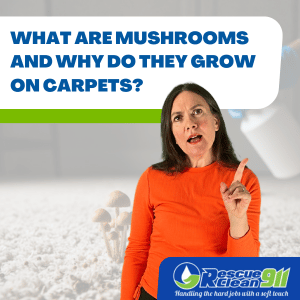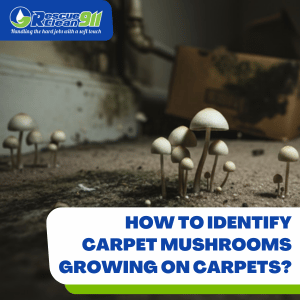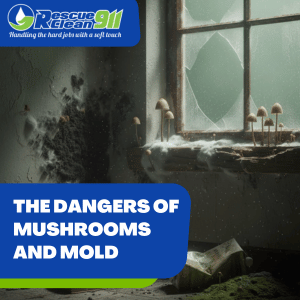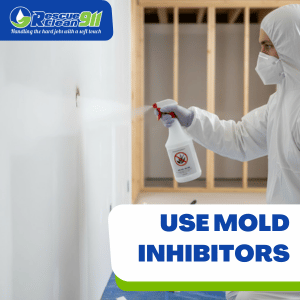If you’re wondering how to get rid of mushrooms growing on carpet, you’re not alone—this issue is more common than many homeowners realize.
Mushrooms are a type of fungus that thrives in damp, dark, and humid conditions, making carpets an ideal breeding ground when exposed to excess moisture, poor ventilation, or water damage.
Mushrooms are more likely to grow in certain areas of your house, not only on wet/damp carpet underneath or behind furniture. They can grow in too much moisture in warm and dark places and wet areas.
One of these includes the bathroom because it contains very high levels of moisture and humidity. Mushrooms can also be found growing in the basement, as it contains lower sunlight levels and also slightly higher humidity.
This guide will explain the first signs, potential health effects, and detailed steps for removal and prevention.
Tools and Products for Effective Mushroom Removal
Essential tools include:
Gloves, mask, and safety goggles
Vacuum with HEPA filter
Steam cleaner
Bleach or commercial mold removal solution
Baking soda for moisture absorption
Mold inhibitors for prevention
How to Get Rid of Mushrooms Growing on Carpet: Step-by-Step
Mushrooms growing on carpets are often the first signs of underlying issues like leaks, high humidity, or hidden mold growth.
While there are mushrooms that are harmless and safe for human consumption, there are a few poisonous kinds, and some can produce toxins that cause skin irritation or respiratory problems.
To address the problem effectively, follow these steps:
 Step 1: Identify the Mushrooms
Step 1: Identify the Mushrooms
Look for small clusters with white or light-colored caps and a stalk.
Check areas near walls, under furniture, or in damp spots like the bathroom or basement.
Be aware of musty odors, which indicate fungus or mold spores in the air.
Step 2: Protect Yourself
Mushrooms can release toxic spores. Wear gloves, a mask, and protective eyewear, especially if pets or children are in the house. Avoid touching mushrooms directly with your bare hands.
Step 3: Remove the Mushrooms
Pull mushrooms carefully by hand to prevent spores from spreading.
Use a heavy piece of furniture to gently press and lift stubborn mushrooms.
For the remaining spores, vacuum the entire room, paying close attention to corners and under furniture.
Step 4: Disinfect and Dry
Apply a bleach solution or a commercial mold removal product to the affected areas.
Rinse thoroughly and ensure the carpet is completely dry.
Use fans or a dehumidifier to reduce humidity and prevent mold growth.
Step 5: Consider Carpet Replacement
If the mushroom infestation is widespread, replacing the carpet is often the safest option. New carpeting prevents more mushrooms from appearing and helps maintain a healthy home environment.
If you are unsure how to remove the mushroom or if it is growing on a delicate surface, it is best to contact a professional. They will have the experience and knowledge necessary to safely and effectively remove the mushroom.
What Are Mushrooms and Why Do They Grow on Carpets?
Mushrooms are a type of fungus that requires moisture, darkness, and an organic food source to thrive. On carpets, common causes of mushroom growth include:
 Leaks immediately after a roof, pipe, or plumbing issue
Leaks immediately after a roof, pipe, or plumbing issueExcess moisture trapped under furniture
Poor ventilation in bathrooms, basements, or rooms with heavy humidity
Wet or damp carpets from spilled water or pet accidents
Mushrooms may appear harmless, but some species are toxic and can cause serious issues, including health effects from spores, such as respiratory irritation, allergic reactions, or skin contact problems.
Replace the carpet with new carpeting once the carpet mushrooms are removed. It helps to prevent mold growth.
If that’s not possible, you can try using a commercial mushroom killer or an over-the-counter enzyme cleaner. Vacuum clean all corners of your home and use a steam cleaner to disinfect all surfaces safely.
How to identify carpet mushrooms growing on carpets?
Mushrooms can be identified by their appearance and the environment in which they grow.
 For example, most mushrooms that grow on carpets typically have a white or light-colored cap and a stalk. They may release mushroom spores. Extract the mushroom spores to prevent them from germinating.
For example, most mushrooms that grow on carpets typically have a white or light-colored cap and a stalk. They may release mushroom spores. Extract the mushroom spores to prevent them from germinating.
If you are unsure whether or not a mushroom is safe to eat, it is best to consult a professional. If you find mushrooms growing on your carpet, there are several things you can do to get rid of them.
First, try to remove the mushrooms by hand. It is better to use safety gear.
If this is not possible, you can vacuum them up or use a damp cloth to wipe them away.
You should also take steps to prevent mushrooms from growing back, such as keeping your carpet clean and dry and using a fungicide.
Not all mushrooms are poisonous. But be careful in identifying the mushrooms growing in your carpet or any part of your home.
If you don’t know how to differentiate mushrooms, Rescue Clean 911 is here to help you. We are experts and professionals in a Biohazard company that cares for your family’s health and home.
The Dangers of Mushrooms and Mold
The dangers of eating mushrooms growing on carpets are numerous.
 First, it isn’t easy to know what type of mushroom is growing on the carpet. Some mushrooms are poisonous and can cause serious health problems.
First, it isn’t easy to know what type of mushroom is growing on the carpet. Some mushrooms are poisonous and can cause serious health problems.Even if people do not eat poisonous mushrooms, they could still get sick by handling them or breathing in their spores.
Ingesting any mushroom can also be dangerous, as some mushrooms are toxic and can cause liver damage.
Finally, eating mushrooms growing on carpets can also lead to intestinal problems, as the mushrooms contain harmful bacteria.
If you think you have eaten a poisonous mushroom, seek medical help immediately. If you have any questions about the safety of eating mushrooms, it is best to speak with a medical professional.
Pets and children are especially vulnerable. Prompt action can prevent further mushroom spread. Be attentive to any unusual stains on the carpet or walls, as these can be early signs that mushrooms might start growing underneath the surface.
If you notice that drying damp spots or cleaning affected areas is taking longer than usual, it could mean hidden moisture is trapped in the carpet or floor. Addressing this early helps prevent mushroom growth and future mold problems.
How to Prevent Mushroom Growth in Carpets
Exposure to sun and fresh air can help dry damp areas faster and discourage mushroom growth.
Preventing mushrooms and mold starts with controlling moisture and humidity. Strategies include:
1. Fix Leaks Immediately
Addressing leaky roofs, pipes, or wall cracks stops the excess moisture that mushrooms need to grow. Avoid letting water sit or wait on the carpet for too long, as this can create the perfect environment for fungi to develop.
2. Improve Ventilation
Ensure proper ventilation in bathrooms, kitchens, and basements
Open windows and use fans or vents to circulate air
Avoid leaving damp clothing, towels, or wet rugs on carpeted floors
 3. Use Mold Inhibitors
3. Use Mold Inhibitors
Commercial mold inhibitors help prevent mold growth and reduce spores on affected areas. Avoid leaving wet clothes or dishes lying around. Moist environments can cause black molds and trigger mushroom sprouting.
4. Keep Carpets Clean and Dry
Always clean surfaces thoroughly to remove hidden germs and spores that can affect your body and overall indoor health. After cleaning, allow the carpet to rest in a well-ventilated area until it’s fully dry.
Vacuum regularly to remove dirt and spores
Use a steam cleaner to eliminate excess moisture
Sprinkle baking soda on damp spots to absorb moisture, then vacuum
5. Monitor High-Risk Areas
Bathrooms, basements, and rooms with poor ventilation
Areas with heavy furniture or water damage
Spaces where pets frequently sit or sleep
Responding to Mushroom Infestations
Prompt response prevents mushrooms from spreading and reduces mold growth risk. Steps include:
Identify and remove mushrooms carefully
Disinfect affected areas thoroughly
Dry the carpet and the room completely
Inspect furniture, walls, and floors for spores
Call professionals for serious issues or high levels of spores
 When to Call Professionals
When to Call Professionals
If mushrooms keep appearing or water damage persists, professional intervention is recommended. Experts can:
Inspect the entire room for hidden mold growth
Safely remove affected areas
Treat the home with mold inhibitors
Repair leaks or poor ventilation issues
Further problems may occur if the mushrooms growing on the carpet continue to spread. Call Rescue Clean 911 at 561-782-1392 for a water damage inspection that may also lead to the growth of mushrooms. We also provide a free estimate.
Key Takeaways!
Mushrooms growing on carpet are a sign of moisture, poor ventilation, or water damage. Addressing the problem early can prevent more mushrooms, eliminate mold spores, and protect your home from serious issues. By following proper cleaning, disinfecting, and preventive measures, you can maintain a healthy, fungus-free environment.
Remember, knowing how to get rid of mushrooms growing on carpet is the first step to protecting your home, family, and pets from the health effects of mold and toxic fungus.







